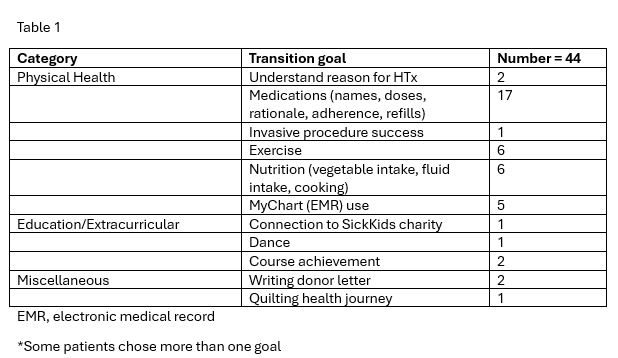Self-selected transition goals: A tool for adolescent heart transplant recipients in preparation for transition to adult care
Lauren Scavuzzo1, Amelia Marrato1, Anne Dipchand1.
1The Hospital for Sick Children, Toronto, ON, Canada
Purpose: Transition goals promote autonomous participation of adolescents in personal healthcare. We review adolescent heart transplant (HTx) recipients who were asked to independently choose a transition goal with an aim to categorize the goals, quantify early success rates and describe healthcare provider engagement in goal achievement.
Methods: We retrospectively reviewed all adolescent (12-18y) HTx pts since 2021 when transition goals started being discussed at nurse practitioner (NP) involved clinic visits. Those unable to participate due to communication challenges were excluded. Here, we describe the experience to early 2025.
Results: 45/49 pts were eligible to participate (68% female, median age at HTx 3.8y (1wk-16yrs) mean age at goal setting 13.9±1.0y). 4 pts were excluded (developmental exceptionalities, 1; non- verbal, 3). To date, 30/44 (68%) pts have chosen and are working towards at least 1 goal (range 1-3) with 44 goals created in total. Delays in selecting goals (n=13) were due to health changes, early adolescence (recently turned 12 y), or psychosocial barriers. 43 (97%) goals were created during NP led visits, 30 (68%) in-person and 14 (32%) virtual. 1 (3%) goal was created during an HTx fellow led visit. Goals (Table 1) categorized as physical health (86%), education/extracurricular (11%) and miscellaneous (3%).

To date 12 (39%) pts have achieved 1 goal. The average time to complete a goal was 1.2±0.8 y. 5/12 (42%) goals achieved were provider facilitated goals, where the NP or other provider supported the adolescent with information or tools to achieve the goal, and 7 (58%) were independent achievements.
Conclusion: This early review of the implementation of self-selected transition goals as a tool in promoting autonomous participation in transition preparation for adolescent HTx recipients, has revealed that most self-selected goals involve HTx related care or heart healthy lifestyle. It is also not always necessary for a healthcare provider to facilitate goal achievement, but NPs play a crucial role in partnership with adolescents. Goal setting was feasible starting in early to mid-adolescence. Delays in participating were related to acute changes in health status, early adolescence or psychosocial challenges. This novel transition tool in promoting self-management in adolescent HTx recipients could offer a way to enhance adolescent engagement and improve outcomes post transition to adult care.
References:
[1] heart transplant
[2] transition
[3] self-management
[4] nurse practitioner
Lectures by Amelia Marrato
| When | Session | Talk Title | Room |
|---|---|---|---|
|
Fri-19 07:00 - 08:00 |
SickKids: Empowering adolescents: Team-based multidisciplinary care | Panelist: Nurse practitioner perspective | MOA 6 |
|
Thu-18 08:00 - 09:30 |
AHP Pre-Congress Workshop - Professional burnout causes and consequences | Professional stressors: a nursing perspective | MOA 4 |
|
Sat-20 10:00 - 11:00 |
Special topics in transplantation | Self-selected transition goals: A tool for adolescent heart transplant recipients in preparation for transition to adult care | MOA 3 |
